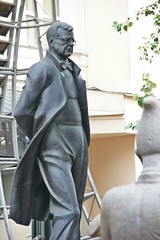Shostakovich, String Quartet No. 3, Op. 73
Callin Quartet:
 |
| (Museum of Modern Art) (Photo credit: jaime.silva) |
Sophia Bæk, violin
Stine Hasbirk, viola
Therese Åstrand, cello.
Allegretto
Moderato con moto
Allegro non troppo
Adagio
Moderato.
Dmitri Shostakovich, 1906-1975
String Quartet No. 3, F major, Op. 73, 1946
Just after World War II, Shostakovich, then forty, turned once again from his public orchestral music to his private chamber music, composing his String Quartet No. 3 in F major, Op. 73. While he had already written nine symphonies, Shostakovich was just settling into his emerging series of string quartets that would eventually comprise fifteen quartets written throughout his mature life, including some of his very last compositions. Many feel that the String Quartet No. 3 is among is his best quartets; it was a favorite of the composer himself. It shows Shostakovich in his full powers as a chamber music composer, skillfully deploying the string quartet to express his utterly distinctive musical personality. From a technical standpoint, the quartet, like many of his later quartets, features an astonishing range of textures, sonic effects and brilliant part writing in the service of music with startling emotional and psychological impact. Successful as abstract musical expression on the one hand, it is nearly impossible to miss the topical and programmatic nature of the quartet, another aspect common to most of Shostakovich's chamber music. The unspeakable hardships of life in the Soviet Union up through the end of WWII took their toll on Shostakovich: nervous, bitter and depressed, he found his most profound outlet in the safe privacy and intimate expressive capability of chamber music. String Quartet No. 3 is a particularly powerful example.










